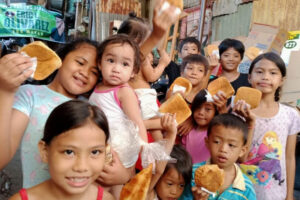Food banking to alleviate hunger: Inspired by Pope Francis
It was in 2013 that the world first learned about Pope Francis’ commitment to the urgent task of eradicating hunger when he visited the UN World Program. He gave the full support of the Catholic Church to eliminating hunger, especially among children all over the world.

(Part 2)
It was in 2013 that the world first learned about Pope Francis’ commitment to the urgent task of eradicating hunger when he visited the UN World Program. He gave the full support of the Catholic Church to eliminating hunger, especially among children all over the world.
Not too long after that historic visit, he wrote the encyclical Laudato Si, addressed to all men and women of good will, where he lamented about the prevailing culture of waste or the “throw-away culture” through which millions of tons of food are thrown away as surplus (especially in the United States) while tens of millions of people are going to bed hungry every day.
This message reverberated around the world, including the Philippines, and inspired a group of businesspeople led by industrialist Jose Sandejas to do something concrete to address this problem affecting millions of people in the Philippines.
Motivated by the Christian imperative of undertaking corporal works of mercy (the first of which is to feed the hungry), this group, following the usual practice in business to do environmental scanning as a step towards strategic planning of any enterprise, turned to data of the World Bank (where the Pope first announced his great interest in mobilizing the Catholic Church to fight world hunger).
The key findings of the World Bank can be summarized as follows:
1.) Undernutrition is, and has always been, a serious problem in the Philippines. For nearly 30 years, there have been almost no improvements in the prevalence of undernutrition in the Philippines. One in three children (29%) younger than five years old suffer from stunting, or being small in size for their age. The Philippines is ranked 5th among countries in East Asia and the Pacific region with the highest prevalence of stunting and is among the 10 countries in the world with the highest number of stunted children.
Micronutrient undernutrition is also highly prevalent in the Philippines: 38% among infants six to 11 months old; 26% among children 12 to 23 months old; and 20% of pregnant women are anemic. Nearly 17% of children aged six to 59 months suffer from Vitamin A deficiency, of which children aged 12-24 months have the highest prevalence (22%) followed by children aged six to 12 months (18%).
2.) Good nutrition is a foundation for economic prosperity, and investments in nutrition are highly cost-effective. The persistence of very high levels of childhood undernutrition, despite decades of economic growth and poverty reduction could lead to a staggering loss of the country’s human and economic potential. A Filipino child with optimal nutrition will have greater cognitive development, stay in school longer, learn more in school, and have a brighter future as an adult, while undernutrition robs other children of their chance to succeed.
The burden on the Philippine economy brought about by childhood undernutrition was estimated at $4.4 billion or 1.5% of the country’s GDP in 2015. The country’s Human Capital Index (HCI) of 0.52 indicates that the future productivity of a child born today will be half of what they could have been achieved with complete education and full health. In 2013, it was estimated the benefit cost ratio for nutrition investments in the Philippines at 44. In other words, every dollar invested in nutrition has the potential of yielding $44 return. A lower estimate projecting benefits accruing from a nutrition intervention scenario (NIS) at the national level through key nutrition-specific interventions rolled out over 10 years at full coverage reaches $12.8 billion over a 10-year period with a corresponding cost of $1.062 billion, yielding a benefit cost ratio of 12:1.
Predictably, the World Bank recommended certain policy and programmatic actions to the Philippine Government to address the challenge of reducing childhood undernutrition. Among these were building a strong and more coordinated partnership for nutrition by strengthening the National Nutrition Council to provide the supervisory and oversight capacities needed for programs to run effectively and efficiently and be enabled to respond to gaps in program implementation.
It was also suggested that high priority and strong support for nutrition should be on the agenda of both the executive and legislative bodies in the municipalities. I was personally aware that at least two progressive LGUs — Quezon and Bataan provinces — were implementing the so-called 1,000-day nutrition program for pregnant mothers and children until the age of two (approximately 1,000 days) to address the most crucial period of growth of a human being to avoid damage to the brain due to undernutrition and malnutrition.
It was obvious to the group of concerned businesspeople that the Government needed help from the private sector (both business and civil society) to implement the recommendations of the World Bank. It is a well-known practice in the Philippines that the business and the NGO sectors try as much as possible to fill in the inadequacies and shortcomings of the public sector. That is why one of the strengths of Philippine society — despite our many weaknesses — is the very vibrant NGO sector.
Fortunately, in 2016, when Lito Sandejas and his colleagues from the private sector resolved to do something about the serious problem described in the World Bank report — and were encouraged by the words of Pope Francis about a throw-away culture — I was still sitting in the board of one of the leading manufacturers of milk products in the country: the Alaska Milk Corp.
It did not take much convincing for Alaska’s CEO then, Freddie Uytengsu, Jr. (famous in local sports circles for promoting basketball and the Ironman events) to agree that the firm’s soon-to-expire (SOTEX) milk products be donated to orphanages and other institutions so the children could be better nourished with protein-rich milk products.
This first experience of donating SOTEX food products to alleviate the hunger of children would give rise to the organization of the Philippine Food Bank Foundation. The incorporators of the Foundation were Lito Sandejas, the late Jaime Ladao, Danilo Navarro, Rafael (Itong) Torres, and myself. We were soon joined on the board by Quintin Pastrana, Chito Perez, and architect Mike Torres. Through the generosity of the business enterprises owned by Lito Sandejas, the cash expenses of the Foundation (manpower, warehousing, logistics and transport) were subsidized.
Since milk products were the most suitable for the children in the orphanages and other feeding clinics such as those in the public schools, we were fortunate that Alaska’s example was soon followed by other milk manufacturers such as Anchor Milk, Arla, Century Pacific, Holly’s, and Meadow Fresh.
Since hunger cuts across all ages, the Foundation actively sought donations of food products from a variety of manufacturers and food establishments like All Day Supermarket, Alegro Beverage Corp., Amici Pasta, Andre Kahn Vegetables, Bizu, Caramia Cakes, Colgate-Palmolive Phils., Concept Foods, Delbros, Del Monte Phils., Dole Philippines, Dunkin Donuts, Energen, Gardenia Bakeries, Green Cross, Jollibee, Krispy Kreme, Makati Sports Club, Mama Sita’s, Mary Grace, Monde Nissin Corp., Nutri-Asia, Pan de Manila, Pick-Up Coffee, Procter & Gamble, RFM Corp., Shakey’s Pizza, Starbucks, Subway, Toscana Farms, Unilever Philippines, and URC.
Also, a very crucial partner is the transport delivery company, Grab, that donates its logistics services for the transport of goods either directly to the recipient institution from the donor company or from the donor company to the Foundation’s warehouse. As of this writing, the Food Bank is delivering food donations not only in the National Capital Region, but to municipalities in cities and provinces like Cebu, Iloilo, Cagayan de Oro, Davao, Pampanga, and Tarlac.
(To be continued.)
Bernardo M. Villegas has a Ph.D. in Economics from Harvard, is professor emeritus at the University of Asia and the Pacific, and a visiting professor at the IESE Business School in Barcelona, Spain. He was a member of the 1986 Constitutional Commission.













